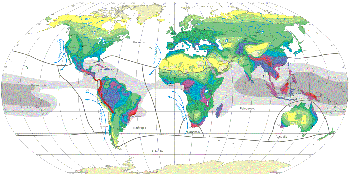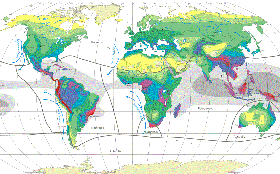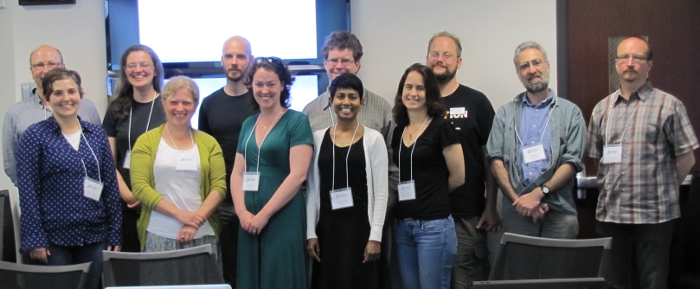| Description | Participants | Summaries | Products |
|---|

Archived NIMBioS Working Group
Dispersal Biogeography
Topic: Demography, Dispersal, and Distributions: A Synthesis
Meeting dates: May 11-14, 2015; March 17-19, 2016
Organizers:
Brittany Teller, Ecology, Utah State Univ.
James Bullock, Centre for Ecology and Hydrology, Oxford, UK
Mark Lewis, Mathematical Sciences and Biological Sciences, Univ. of Alberta, Canada
Objectives: Understanding species' spatial distributions is a fundamental issue in ecology, which can only be addressed by considering both geographic context and species' traits. However, the two most widely used predictive approaches, species distribution models (SDMs) and demography and dispersal models (DDMs), follow different research traditions and thereby treat distributions and species' traits in fundamentally different ways. This lack of synthesis constrains the predictive power of both model types, especially under perturbations such as climate change. Although SDMs predict species distributions by estimating environmental niches defined by abiotic variables (e.g., temperature, precipitation), they often ignore local population dynamics and dispersal, which enable species to reach and survive in suitable environments. DDMs explicitly incorporate dynamics and dispersal and are mathematically rigorous, but do not often incorporate geographic variation in abiotic conditions. We seek to reduce these constraints by determining the contexts in which these two popular approaches can be mutually informative. During a short-term visit to NIMBioS, we developed a mathematical framework that brings together SDMs and DDMs, and we conjectured that our new synthesis could be a powerful tool for predicting species distributions under both static and changing environmental conditions. This working group will refine this framework for empirical applications and test it with real data, especially for species and regions under a particular threat from environmental change. Indeed, predicting species distributions with higher precision and confidence is a research priority in our climatically, agriculturally, and economically changing world. Our research will contribute mathematical instruments for achieving this goal.

Meeting Summaries
| Mtg # | Dates | Agenda | Summary | Photo | Evaluation |
|---|---|---|---|---|---|
| 1 | May 11-14, 2015 | Link | Link | Report | |
| 2 | Mar 17-19, 2016 | Link | Link |
Meeting 1 Summary. During our first working group meeting, we surveyed current theoretical and empirical approaches for estimating species demography and distributions. We developed our own framework with three research foci: theoretical modelling, empirical approaches, and evolution. As we developed empirical approaches, we also considered potential datasets in which we could test the utility of our approaches for managing vulnerable ecosystems. We reviewed the draft of our first manuscript, coded a simulation model, organized viable sub-groups around each research focus, and planned for future meetings.
Meeting 2 Summary. Our second working group meeting was very successful. We began by discussing the value of analytical tractability in problems of geography with demography and distributions. We then reviewed the datasets we had compiled, and we developed three empirical systems in which to test our approaches. In one system, we examined broad patterns of geographic spread and isolated important contributions of landscape features for species movement. In another system we compare d known dispersal patterns to those inferred from observations. And, in the final research focus, we examined the role of dispersal distance in evolutionary contexts. Each of these approaches is revealing important considerations for species movement that should be examined in modelling and predictive work. As we develop the results for these projects, we hope to identify both important species-level processes, as well as to find intriguing comparisons between and across species.
 |
| Meeting 1 participants (L to R): James Bullock, A. Michelle Lawing, Katriona Shea, Elizabeth Crone, Antonin Machac, Brittany Teller, Mark Lewis, Priyanga Amarasekare, Catherine Graham, Nick Matzke, Ben Bolker, Sergei Petrovskii. |
 |
| Meeting 2 participants (L to R): James Bullock, Nick Matzke, Brittany Teller, Cristian Dambros, Priyanga Amarasekare, Katriona Shea, Elizabeth Crone, Ben Bolker and Mark Lewis. |
NIMBioS Working Groups are chosen to focus on major scientific questions at the interface between biology and mathematics. NIMBioS is particularly interested in questions that integrate diverse fields, require synthesis at multiple scales, and/or make use of or require development of new mathematical/computational approaches. NIMBioS Working Groups are relatively small (up to 10 participants), focus on a well-defined topic, and have well-defined goals and metrics of success. Working Groups will meet up to 3 times over a two-year period, with each meeting lasting up to 2.5 days.
A goal of NIMBioS is to enhance the cadre of researchers capable of interdisciplinary efforts across mathematics and biology. As part of this goal, NIMBioS is committed to promoting diversity in all its activities. Diversity is considered in all its aspects, social and scientific, including gender, ethnicity, scientific field, career stage, geography and type of home institution. Questions regarding diversity issues should be directed to diversity@nimbios.org. You can read more about our Diversity Plan on our NIMBioS Policies web page. The NIMBioS building is fully handicapped accessible.
NIMBioS
1122 Volunteer Blvd., Suite 106
University of Tennessee
Knoxville,
TN 37996-3410
PH: (865) 974-9334
FAX: (865) 974-9461
Contact NIMBioS


